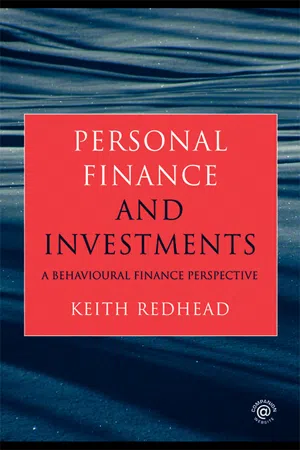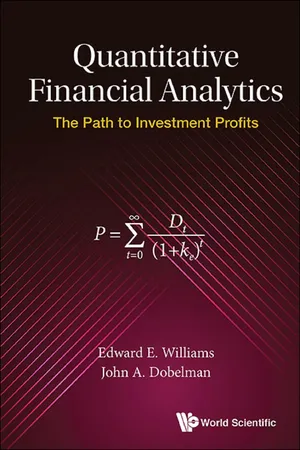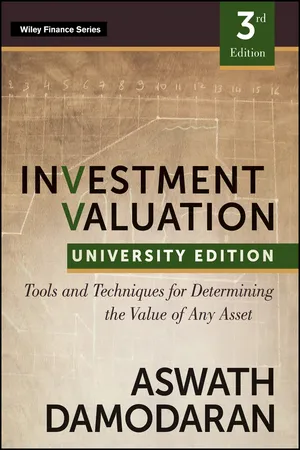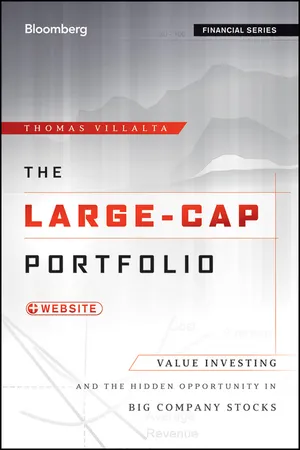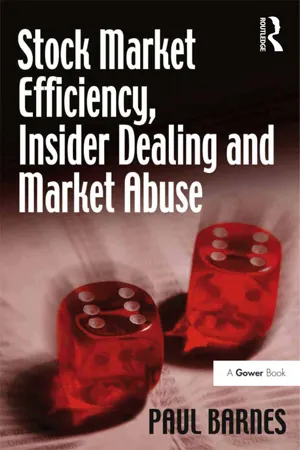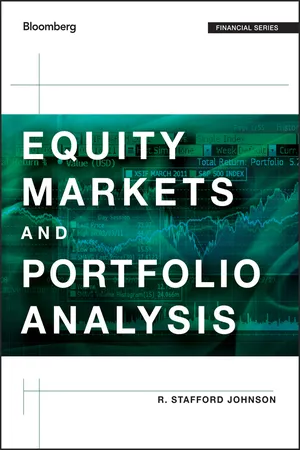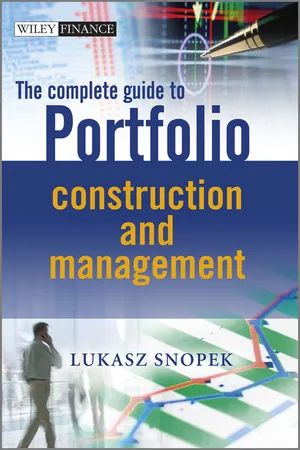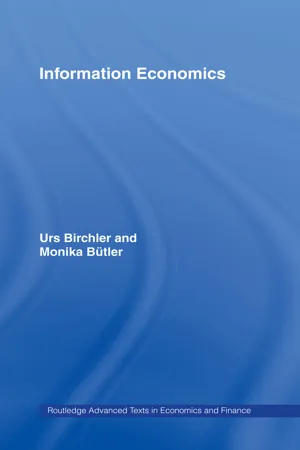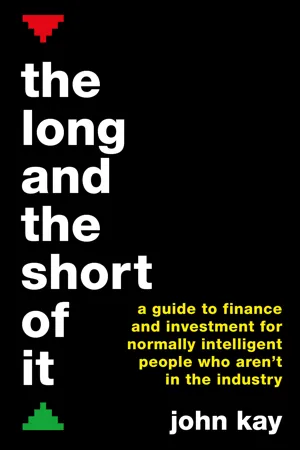Business
Semi-Strong Market Efficiency
Semi-Strong Market Efficiency is a concept in finance that suggests that all publicly available information is quickly and accurately reflected in stock prices. In a semi-strong efficient market, it is believed that stock prices adjust rapidly to new information, making it difficult for investors to consistently outperform the market by using publicly available information. This concept is an important consideration for investors and financial analysts when making investment decisions.
Written by Perlego with AI-assistance
Related key terms
10 Key excerpts on "Semi-Strong Market Efficiency"
- eBook - ePub
Personal Finance and Investments
A Behavioural Finance Perspective
- Keith Redhead(Author)
- 2008(Publication Date)
- Routledge(Publisher)
A purpose of using investment analysis to estimate the fair prices of shares is to assist in investment decisions. If the market price of a share is below its fair price, it is cheap and therefore a potential buy. If the fair price is below the market price, the share is overpriced and should not be bought.The efficient market hypothesis suggests that such investment analysis is futile. This is because either (1) share prices already reflect all relevant known information with the effect that they are already at their fair prices, or (2) it is not possible to make profits from any mispricing.A semi-strong form efficient market is one in which security prices take account of all publicly available information. In addition to market information on past prices and trading volumes, publicly available information includes macroeconomic data (such as interest rates and inflation rates), company data (such as profits, sales, quality of management and workforce, balance sheets), and non-economic events (such as political events, technological developments, and discoveries of natural resources). The implication is that asset prices immediately move to reflect any new information or that no one can make profits by means of purchases or sales based on analysing the new information.EVIDENCE SUPPORTING SEMI-STRONG FORM EFFICIENCY
The evidence indicating the existence of anomalies is evidence against the semi-strong form of the efficient market hypothesis. Much of the evidence supporting the semi-strong form of the efficient market hypothesis comes from event studies.These studies aim to establish whether it is possible to make profits from a publicly available item of news, particularly financial news relating to a specific company. If stock prices adjust very quickly to news, the market is efficient and there is no scope for trading profits following the news. If stock prices adjust slowly there is an opportunity for ascertaining, and trading upon, the direction of price change. Slow price changes indicate market inefficiency. - eBook - ePub
Quantitative Financial Analytics
The Path to Investment Profits
- Edward E Williams, John A Dobelman;;;(Authors)
- 2017(Publication Date)
- WSPC(Publisher)
σ and cannot be used if prices (and, thus, returns) are so distributed. Fama has demonstrated, however, that a similar form of analysis, employing a different dispersion parameter, can be employed. See Eugene F. Fama (1965).Although the weak tests of capital market efficiency dealt with the inability to make profitable predictions of future prices from past prices, a second form of testing (called the “semi-strong efficient market hypothesis”) attempted to prove that prices reflect all available information. These tests sought to demonstrate that new information results in a rapid adjustment to a new equilibrium price that, by implication, is taken to demonstrate that the price at any time must reflect available information. Specifically, the tests took events such as announcements of stock splits, earnings, dividends, interest-rate changes, and so on, and studied (1) how rapidly a price adjustment was made and (2) whether the price adjustment was an unbiased evaluation of the information (such that subsequent adjustments were as likely to be in one direction as the other). The results of the tests confirmed that price adjustments occur rather quickly after the first public announcement of the information, implying that at least a significant portion of the market receives and interprets the information quickly. It follows, then, that the initial price adjustment has been generally found to be unbiased. A price trend caused by the slow spread and interpretation of new information could result in a profitable return for swift action; that such a trend does not occur seems affirmed.In a crude sense, it could be said that the weak tests indicate that one cannot become wealthy as a technician (forecasting price or return movements based on past behavior), and the semi-strong tests indicate that, by the time one reads some new information, it is too late to profit from it. The theory still allows a person possessing superior information or analytical techniques to expect a better-than-normal return. A third form of testing (called the “strong efficient market hypothesis”) went all the way to asking if there can be any information not reflected in the price of a security such that anyone can expect above-average profits. During the 1920s, it was claimed that “any day is a good day to buy a good stock.” If the strong form of the efficient capital market hypothesis held, then, “any day is as good as any other day to buy any stock (or bond, or mutual fund, and so on).” - eBook - ePub
Investment Valuation
Tools and Techniques for Determining the Value of any Asset, University Edition
- Aswath Damodaran(Author)
- 2012(Publication Date)
- Wiley(Publisher)
Definitions of market efficiency are also linked up with assumptions about what information is available to investors and reflected in the price. For instance, a strict definition of market efficiency that assumes that all information, public as well as private, is reflected in market prices would imply that even investors with precise inside information will be unable to beat the market. One of the earliest classifications of levels of market efficiency was provided by Fama (1971), who argued that markets could be efficient at three levels, based on what information was reflected in prices. Under weak form efficiency, the current price reflects the information contained in all past prices, suggesting that charts and technical analyses that use past prices alone would not be useful in finding undervalued stocks. Under semi-strong form efficiency, the current price reflects the information contained not only in past prices but all public information (including financial statements and news reports) and no approach that is predicated on using and massaging this information would be useful in finding undervalued stocks. Under strong form efficiency, the current price reflects all information, public as well as private, and no investors will be able to find undervalued stocks consistently.IMPLICATIONS OF MARKET EFFICIENCYAn immediate and direct implication of an efficient market is that no group of investors should be able to beat the market consistently using a common investment strategy. An efficient market would also carry negative implications for many investment strategies:- In an efficient market, equity research and valuation would be a costly task that would provide no benefits. The odds of finding an undervalued stock would always be 50–50, reflecting the randomness of pricing errors. At best, the benefits from information collection and equity research would cover the costs of doing the research.
- In an efficient market, a strategy of randomly diversifying across stocks or indexing to the market, carrying little or no information cost and minimal execution costs, would be superior to any other strategy that created larger information and execution costs. There would be no value added by active portfolio managers and investment strategists.
- eBook - ePub
The Large-Cap Portfolio
Value Investing and the Hidden Opportunity in Big Company Stocks
- Thomas Villalta(Author)
- 2012(Publication Date)
- Bloomberg Press(Publisher)
Semistrong-form efficiency posits that public information cannot be used as the basis to profit, as the market assimilates information immediately. In this form, the EMH contends that security analysis of any kind is not a profitable endeavor. Information that is available in the market does not allow for superior knowledge on the part of any one participant, and thus, there is no manner in which to exploit any information. Importantly, this is not to say that some stocks would not be inclined to move higher than others and that one cannot identify stocks with superior return potential. However, the risk that is associated with common stocks with higher potential returns is commensurate with the return premium. Consequently, one is not being compensated for his superior research, but instead for the risk that he is taking with his funds.The strong-form EMH goes one step further, hypothesizing that individuals cannot profit from information of any kind—price, publicly available information, or privately available information.In general, it is thought that weak-form efficiency and semistrong-form efficiency hold, while strong-form efficiency does not. Private, nonpublic, insider information is thought to provide an opportunity for profit and is viewed as unfair in our investment market (and, as a consequence, it is illegal to trade on such information).Empirical Support for the Efficiency of MarketsIt’s also important to note that much of market efficiency is predicated on the inability of investors—professional or nonprofessional—to beat broader stock market indices, net of their fees, over extended time periods.Arguments supporting the notion of market efficiency generally hinge on an inability to profit from said inefficiencies. Often, aggregated mutual fund performance is pointed to as “proof” that markets are efficient, as the average mutual fund generally underperforms the broader market. As explained in Chapter 1, William Sharpe’s influential 1966 paper “Mutual Fund Performance”8 convincingly made the case that markets are sufficiently efficient to render active management futile. In his examination, Sharpe analyzed 34 open-ended mutual funds, looking at a data set that covered the period 1954 to 1963. This examination included balanced funds, equity funds, and income funds and looked at the relative and risk-adjusted performance of this broad group of funds. But, as noted previously, this is but one of many studies (see work by Jenson,9 Carhart,10 - Paul Barnes(Author)
- 2016(Publication Date)
- Gower(Publisher)
This states that share prices adjust immediately and once and for all to new information as it becomes publicly available. There have been many studies that have tested this.It follows that as current market prices reflect all publicly available information, no one can consistently outperform the stock market and earn abnormal returns. There is, therefore, no point in attempting to do so. To quote the authoritative textbook, Brearley and Myers ‘If capital markets are efficient, then purchase or sale of any security at the prevailing market price is never a positive NPV (net present value) transaction’ (2006, p. 289). The important point about the semi-strong form is that it refers only to publicly available information and recognizes the existence of inside information and that those in possession of it can outperform the stock market.Most of the early studies of the semi-strong form were ‘event studies’. These studied the stock market reaction to the announcement of a new piece of information both during the days prior to, and after, the event. They compared the ‘expected’ normal return (based on the market as a whole for the same period) for a sample of shares that had experienced such an event over the period surrounding the event with their actual returns. The difference between the two (expected and actual returns) is referred to as the abnormal return and interpreted as the change in the share price in excess of the market caused by the event or new piece of information. Most studies have used what is known as the Market Model (see the Appendix in this chapter for a mathematical specification of this). If the abnormal returns were statistically significant and occurred prior to, or immediately after, the event or release of new information, they would be regarded as evidence to support the ECMH. Invariably, the evidence from these short-window event studies was consistent with market efficiency.THE STRONG FORM
This states that current market prices reflect all relevant information, whether publicly available or privately held. It is generally believed that all large stock markets are efficient in the weak and semi-strong forms but they are not efficient in the strong form and that insiders and others who profit from inside information exist on a fairly large scale. Whilst academics have had access to the necessary information to test the other forms of the ECMH, they are usually unable to test the strong form because of the secrecy of inside traders. They have usually only been able to go so far as to infer from observed market reactions prior to the announcement of an important piece of news that insider dealing has occurred and on such a large scale as to cause share prices to change (Barnes 1996). These studies are reviewed in Chapter 9- eBook - ePub
- R. Stafford Johnson(Author)
- 2014(Publication Date)
- Bloomberg Press(Publisher)
For example, investors/fundamentalists may be too bullish about an unexpected good earnings announcement, causing the market price to overshoot its equilibrium value. Upon further assessment, the market may correct by slowing purchases or selling, causing the price to move down. During this reassessment period, the volatility of the stock price may increase. Semi-strong-form tests of the EMH do not rule out the possibility that during the assessment period some investors may pay less than the new equilibrium price and thus earn abnormal returns, whereas others may pay more than the equilibrium price and therefore earn returns less than the equilibrium return. Instead, the semi-strong-form tests try to determine if there are enough fundamentalists to ensure that investors, on average, do not earn abnormal returns from trading from events and announcements. As a result, the null hypothesis for the semi-strong-form tests, H ss 0, is: H ss 0 : Investors, on average, cannot earn abnormal returns from trading strategies based on publicly available information. Strong-form tests of the EMH are tests of whether all information—public and private—is fully reflected in the security's price. These tests usually take two forms. One form tries to determine whether or not insiders can earn abnormal returns from their private information. That is, do the officers, managers, engineers, scientists, accountants, and others in the company, as well as those who by the nature of their business are close to the company, have private information that would allow them to earn abnormal returns? In the United States and many other countries, there are security laws that require that insiders list their trades with the SEC. The intent of the laws is to make publicly available trades that are based on privileged information. If these and other laws aimed at inside trading are effective, then a priori we would expect security prices to reflect inside information - Lukasz Snopek(Author)
- 2012(Publication Date)
- Wiley(Publisher)
1 Because the price is given efficiently by the market, any opportunity to generate excess returns will immediately be eliminated by the large number of market participants. Therefore, it is impossible for any investor to outperform the market in the long term.“Conversely, if information is not always correctly nor immediately reflected in prices, this means there are pockets of inefficiency that may be exploited as part of an active portfolio management strategy.”2There are three forms of market efficiency originally defined by Eugene Fama in 1970.6.1 Weak Form Market Efficiency“A market is weak form efficient if prices incorporate all past information .”3 All past information is reflected in the current price, making it impossible to predict future price movements based on past prices.Many studies conducted using technical analysis methods (filters, moving averages) have reached the conclusion that after factoring in transaction costs, it is not possible to beat the market with any consistency.Weak form efficiency also implies that the returns on securities are independent from one period to another, as information is immediately included in the price. However, many tests invalidate the hypothesis of serially independent returns.Empirical studies, in particular by Bondt and Thaler (1985), have demonstrated that investors “overreact”, tending to favour securities that are the subject of good news to the detriment of securities associated with bad news.Evidently, weak form efficiency does not enjoy unanimous support. 6.2 Semi-Strong Form Market Efficiency“A market is semi-strong form efficient if prices incorporate all past and public information . According to this definition, it is impossible to make any excess gains by trading on earnings, dividend or stock split announcements, etc., as this information can be used by anyone once it is made public.”4- eBook - ePub
The Long and the Short of It (International edition)
A guide to finance and investment for normally intelligent people who aren't in the industry
- John Kay(Author)
- 2016(Publication Date)
- Profile Books(Publisher)
You regularly hear statements like these in popular discussion. The weak form of the efficient market hypothesis claims that no such statement can ever be justified because prices move without knowledge of their history. The probability that they will rise next year, or next month, or today, is unaffected by whether prices rose yesterday afternoon, or last week, or in the first quarter of 2011.The weak EMH is a blow for people who rely on projections of historical trends, or identification of recurrent patterns, to make their investment decisions – most of all for chartists, whom I’ll describe in the next chapter. But the weak version does nothing to discourage people from looking at fundamental values. Rather the opposite – the weak EMH encourages you to believe that you might make money at the expense of noise traders by paying close attention to fundamentals.There is a considerable practical difference between weak and strong EMH. Strong EMH – which postulates that everything that could be known about securities is already in their price – essentially rules out any possibility of investment skill. Legendary investors such as Buffett have simply been lucky. No research or analysis can be useful, because its results will be reflected in the market. Put like this, the theory seems absurd.Indeed, the strong version of EMH contains an inherent contradiction. If it were the case that research and analysis could never be profitable, because the result of that research and analysis would always be ‘in the price’, why would anyone undertake such research and analysis? If prices were always efficient, what could be the process by which they become efficient?The semi-strong version of the efficient market hypothesis is less extreme, claiming only that information is ‘in the price’ if publicly available. Thus the semi-strong version does not exclude the possibility that insightful new analysis, unpublished or not yet widely circulated, might be valuable to those who possess it. It certainly permits possibilities of profit from trading on private information. The investment banker who knows of a planned takeover and the corporate executive who knows that the coming results will be worse than is generally expected can both deal advantageously on the basis of this inside information. - eBook - ePub
- Urs Birchler, Monika Bütler(Authors)
- 1999(Publication Date)
- Routledge(Publisher)
37In our example of Alice running for club presidency and Bob hoping for promotion, prices were not fully revealing. They did express the information Alice and Bob were primarily interested in (their individual chances), but they did not reveal the precise pieces of information that had gone into them.... and in the sense of empirical research
In empirical finance literature, informational efficiency is defined somewhat differently as the absence of profit opportunities. The Efficient Market Hypothesis rests on three assumptions (Fama, 1970): (i) No transaction costs, (ii) information is available without cost, and (iii) rational expectations (agreement on the same model generating future returns).There are three levels of efficiency commonly distinguished in the literature:- Strong form : Prices reflect all public and private information in the sense that it does not leave any profitable trading opportunity, even for "insiders".
- Semi-strong form : Prices reflect all public information, thus leaving profit opportunities to parties with private information.
- Weak form : Prices fully reflect the history of past prices. There is thus no profitable trading opportunity based on past prices, or as the saying goes "markets have no memory". Yet, traders may make profits from fundamental research and private information.
7 C d Some paradoxes
The Information Paradox (Grossman—Stiglitz)
The Efficient Market Hypothesis has an important implication, the so-called Information Paradox. - eBook - ePub
The Long and the Short of It
A guide to finance and investment for normally intelligent people who aren't in the industry
- John Kay(Author)
- 2016(Publication Date)
- Profile Books(Publisher)
You regularly hear statements like these in popular discussion. The weak form of the efficient market hypothesis claims that no such statement can ever be justified because prices move independently of their history. The probability that they will rise next year, or next month, or today, is unaffected by whether prices rose yesterday afternoon, or last week, or in the first quarter of 2016.The weak EMH is a blow for people who rely on projections of historical trends, or identification of recurrent patterns, to make their investment decisions – most of all for chartists, whom I’ll describe in the next chapter. But the weak version does nothing to discourage people from looking at fundamental values. Rather the opposite – the weak EMH encourages you to believe that you might make money at the expense of noise traders by close attention to fundamentals.Thus there is a considerable practical difference between weak and strong EMH. Strong EMH – that everything that could be known about securities is already in their price – essentially rules out any possibility of investment skill. Legendary investors such as Buffett have simply been lucky. No research or analysis can be useful, because its results will already be reflected in the market. Put like this, the theory seems absurd.Indeed, the strong version of EMH contains an inherent contradiction. If it were the case that research and analysis could never be profitable, because the result of that research and analysis would always be ‘in the price’, why would anyone undertake such research and analysis? If markets were always efficient, what could be the process by which they become efficient?The semi-strong version of the efficient market hypothesis is less extreme, claiming only that information is ‘in the price’ if publicly available. Thus the semi-strong version does not exclude the possibility that insightful new analysis, unpublished or not yet widely circulated, might be valuable to those who possess it. It certainly permits possibilities of profit from trading on private information. The investment banker who knows of a planned takeover, the corporate executive who knows that the coming results will be worse than those generally expected, can both deal advantageously on the basis of this inside information.
Index pages curate the most relevant extracts from our library of academic textbooks. They’ve been created using an in-house natural language model (NLM), each adding context and meaning to key research topics.
